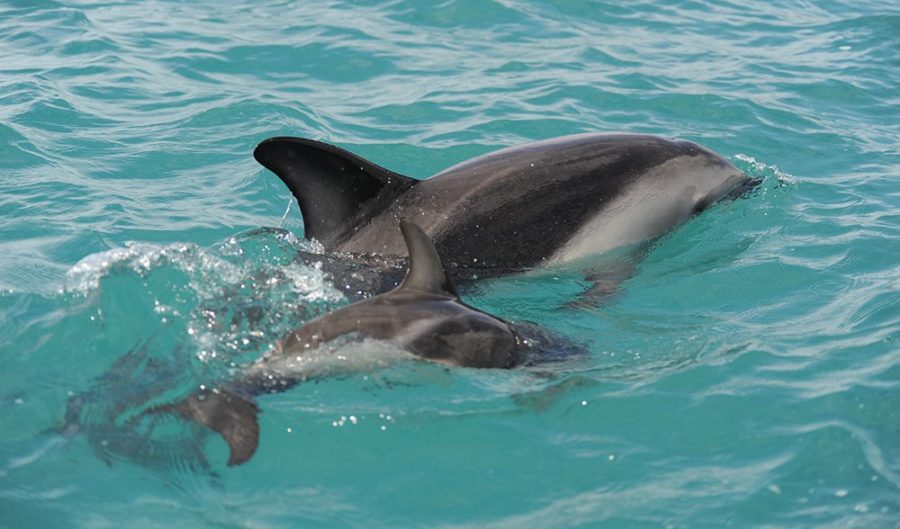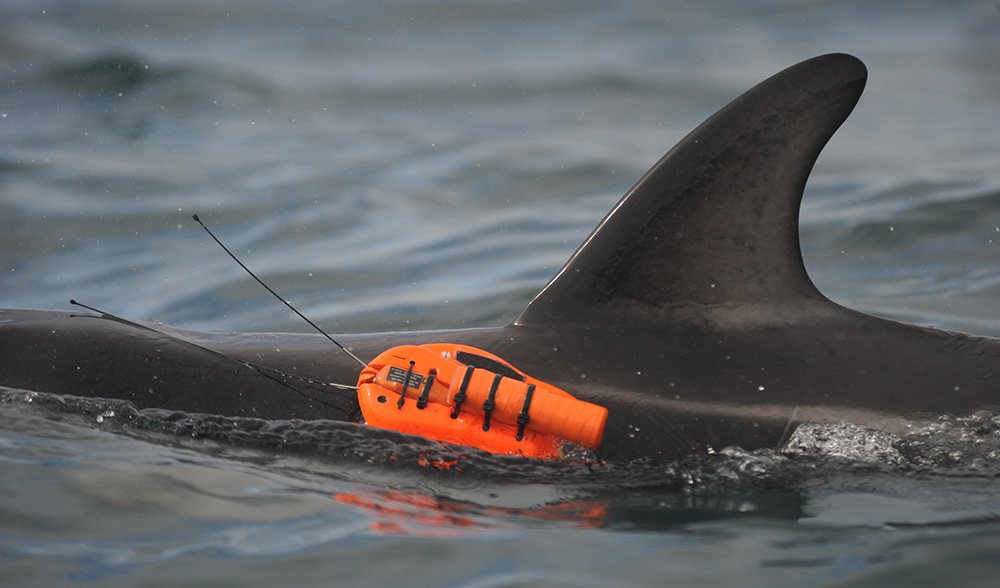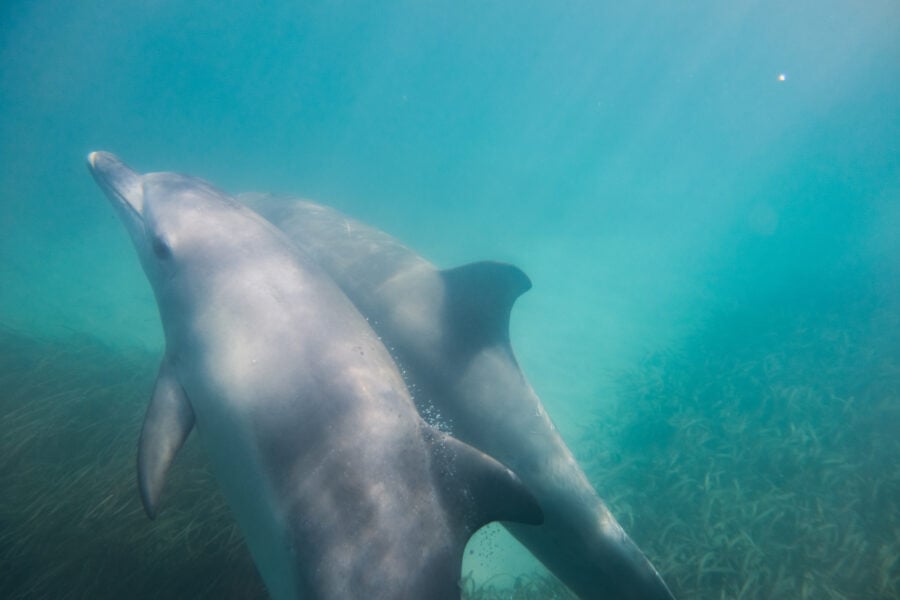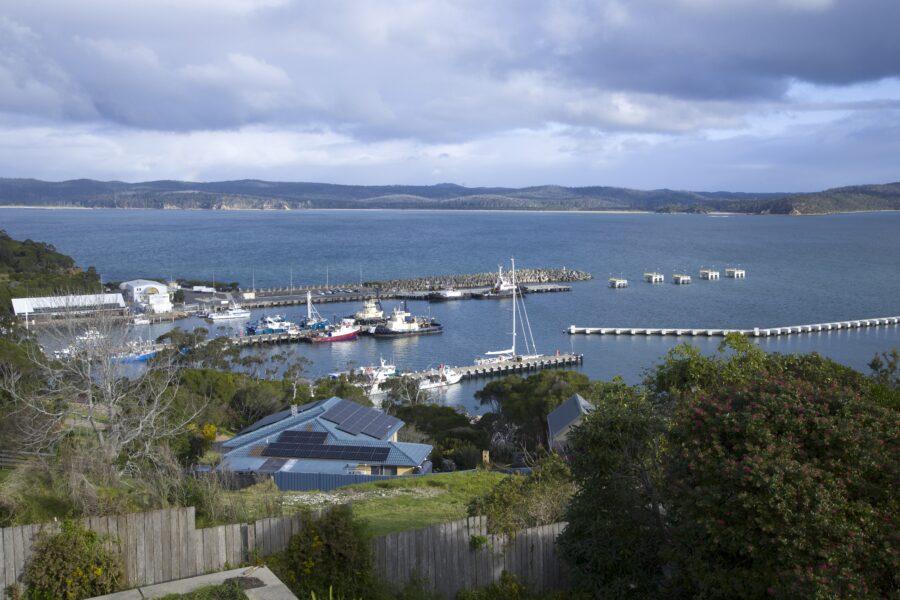Underwater secrets of dolphins revealed

IN A WORLD-FIRST, researchers have used cutting-edge cameras to glimpse life from the point of view of wild dolphins.
The custom-built, non-invasive cameras were attached to eight wild dusky dolphins (Lagenorhynchus obscurus) off the coast of Kaikoura, New Zealand. Nearly nine hours of footage has captured intimate and rarely-seen moments, including mother-calf interactions, playing with kelp, and flipper-rubbing – the dolphin equivalent of hand-holding.
“We’re currently diving deep into the analysis of the footage, looking at social behaviour, hunting strategies, and diving physiology,” says Dr Gabriel Machovsky-Capuska, an ecologist at the University of Sydney’s Charles Perkins Centre.
The new technique, reported in the journal Marine Biology, will provide scientists with exceptional insight into the lives of marine animals compared to traditional above-water monitoring.
“From the surface, researchers can only see about 10 per cent of what is going on in an animal’s life,” said lead author Dr Heidi Pearson, a marine biologist from the University of Alaska Southeast. “With these video cameras, we can ‘see’ from the animals’ perspective and begin to understand the challenges they face as they move throughout their habitat.”

Dusky dolphins photographed by Heidi Pearson during the dolphin tagging work. Photo taken under DOC permit 37696-MAR.
High-tech video cams needed for swift swimmers
A multidisciplinary team of scientists and engineers worked together to develop the camera technology and deploy it – a feat that has previously eluded even the best wildlife documentary makers, due to the speedy nature of cetaceans.
“One challenge of doing this research on small and fast animals like dusky dolphins is that there is limited surface area on the dolphin’s body for tag attachment, so there’s only a small window of time to actually deploy the tag as the dolphin swims past,” exlpained Dr Peter Jones, an engineer from the University of Sydney.
The cameras were attached to the dolphins with suction cups. They eventually fall off and float to the surface, where they can be recovered thanks to satellite transmitters.
According to Gabriel, the dolphins were largely unaffected by the cameras. “The method is non-invasive, which is really important,” he said. In contrast, dive teams can interfere with or influence dolphins’ natural behaviour – think reality TV participants over-acting in front of the camera.

The custom-made cameras were attached to the dolphins using suction cups, and recovered from the water using GPS after they’d fallen off. (Image: supplied)
New filming technique has far-reaching implications
The novel insights gained through this filming technique have the potential to inform us about more than just dolphin behaviour.
The research team believes it will influence conservation of marine animals and future management strategies. “In marine areas subjected to high degrees of human disturbance such as shipping or coastal development, the ability to collect data from the animal’s perspective will be critical in understanding how and to what extent these stressors affect an animal’s ability to feed, mate, and raise young,” said Heidi.
The filming technique will also help us understand the health of the seafood we like to eat. “Dolphins are marine top predators that are considered biomonitors of marine environments,” Gabriel explained. “Gaining a better understanding of their lives will help us to better comprehend the health of marine environments, including prey species like fish and squid that are highly consumed by humans.”
The research team plan to deploy their cutting-edge cameras on a variety of marine predators, such as cetaceans and sharks.
“This is just the tip of the iceberg,” said Gabriel. “If you’d told me twenty years ago that we’d be able to deploy cameras and understand animals from their own perspective like this, I would have been blown away.”
This work was funded by a National Geographic Society/Waitt Fund Grant and the Encounter Foundation.
READ MORE:
- Dolphin ‘mothers group’ discovered
- Bunbury dolphins serve calamari for dinner
- Cartels of cousins run dolphin society




